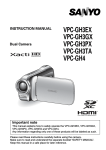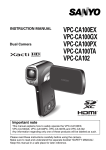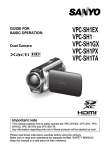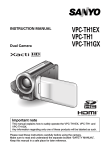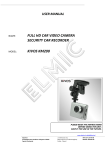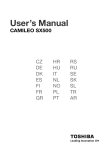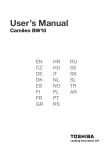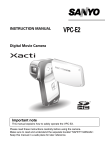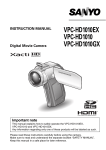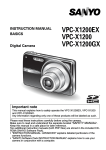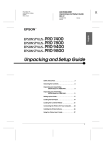Download Sanyo VPC-GH1GX User's Manual
Transcript
GUIDE FOR BASIC OPERATION Dual Camera VPC-GH1EX VPC-GH1GX VPC-GH1PX VPC-GH1TA VPC-GH2 Important note This manual explains how to safely operate the VPC-GH1EX, VPC-GH1GX, VPC-GH1PX, VPC-GH1TA and VPC-GH2. Any information regarding only one of these products will be labeled as such. Please read these instructions carefully before using the camera. Make sure to read and understand the separate booklet “SAFETY MANUAL”. Keep this manual in a safe place for later reference. HOW TO READ THIS MANUAL For first-time users Please read this manual to familiarize yourself with your camera’s operation. ↓ To use the various camera features The Instruction Manual that explains the features in detail can be obtained from our website (page 45). ↓ To use additional features Visit the Sanyo website to learn how to adjust the camera settings for various shooting scenes. There you’ll also find information about the software for playing back data recorded with your camera and for burning (recording) DVDs (page 45). You may find the answers to questions or problems concerning camera operation in the sections “COMMONLY ASKED QUESTIONS” (page 52). Symbols used in this manual HINT CAUTION (page xx) i Points giving some extended instructions or special points to pay attention to. Points that require special attention. Refer to the page indicated for detailed information. English SHOOT, PLAY BACK AND SAVE Preparing the camera 1 Insert the battery pack. 3 Insert the battery pack. 2 Open 1 Push out ▲ ▲ Battery cover 4 Close the battery cover. About saving your recorded data h If you wish to use an SD Memory Card, refer to page 15 to install the card in the camera. h An SD Memory Card is not included with your camera. Please purchase a commercially sold card. h This camera has an internal memory, so you can shoot and record without an SD Memory Card installed. English ii Shooting 1 2 Press the ON/OFF button for at least 1 second to turn the camera on. h If the screen to set the date and time appears, press the MENU button 2 times to cancel it. For how to set the date and time, see page 23. MENU button ON/OFF button Record. To record a video clip: h Press the [ ] button to begin recording a video clip. h Press the [ ] button again to end the recording. To take a photo: h Press the [ ] button. h A still image is captured. [ ] button [ 14M-S 15 iii English ] button Full-HD 000:00:17 Before capturing those important shots, be sure to first take a test shot to confirm that your camera is set up and ready to go i Sanyo declines any claim for compensation for recorded contents etc. in case of photographing or recording failure due to a chance camera or card flaw. Playback 1 2 3 Press the REC/PLAY button. h The display changes to the Playback Screen. Select the image to play back. h Use the arrow keys to move the orange frame to the image you wish to play back. h The image information for the framed image is shown in the bottom part of the monitor. Press the SET button. h Playback begins. <To return to the recording mode> h Press the REC/PLAY button. REC/PLAY button SET button Arrow keys Deleting files 1 2 On the screen in step 2, move the orange frame to the file you wish to delete, and press the MENU button. Select “DELETE”, and press the SET button. Full-HD Orange frame 100-0006 00:00:05 6.5MB OK Remaining battery power indication English iv 3 4 5 Select “DELETE SINGLE”, and press the SET button. Select “DELETE”, and press the SET button. h If you press [G] or [H], the screen to delete a different file will appear. When you are finished deleting files, press the MENU button. h Pressing the MENU button 3 times will return you to the screen in step 2. When you are finished using the camera... Press the ON/OFF button for at least 1 second to turn the camera off. v English Copy data from your camera to the computer Connect your camera to a computer, and copy the desired data to the computer. 1 2 Turn on the computer, and use the supplied dedicated USB interface cable to connect your camera to the computer. h Connect the cable between the camera’s USB/AV terminal and the computer’s USB connector. Turn on the camera (page 20). h The USB Connection Screen appears on the camera’s monitor. USB CONNECTION COMPUTER PRINTER CANCEL To USB/AV terminal CANCEL SET OK To USB connector Supplied dedicated USB interface cable English vi 3 Select “COMPUTER”, and press the SET button. h The screen to select the USB CONNECTION computer connection mode CARD READER appears. MTP SCREEN CAPTURE PC CAMERA CANCEL OK 4 5 6 vii Select “CARD READER”, and press the SET button. h The message [Found New Hardware] appears in the task tray, showing that the camera is recognized as a drive. h The card is recognized (mounted) as a disk, and the [XACTI (E:)] icon appears in the [My Computer] window. h The drive name (E:) may be different on your computer. <If the access menu (page 50) appears> h Click on [Exit] to cancel the access menu. Select an action. h If the [XACTI (E:)] window appears automatically, select the desired procedure from the window. Copy files from the camera to a computer. English Dismounting the camera CAUTION i To disconnect your camera, be sure to follow the procedure below. Failure to follow this procedure may cause faulty operation of your computer or corrupt the files in your camera. 1 2 Left-click on the icon for safely removing hardware in the task tray. h A list appears showing the devices connected to the computer’s USB connector. Left-click on the camera drive (E:). h The camera can now be disconnected. h The drive name (E:) may be different on your computer. No software is included with this camera. Please visit our website to obtain the available software. English viii CONTENTS HOW TO READ THIS MANUAL ............................................................. i CHECKING THE INCLUDED ACCESSORIES ...................................... 3 How to use the accessories ............................................................ 5 ABOUT THE CARD ............................................................................... 9 Media cards that can be used with this camera .............................. 9 What “card” means in this manual .................................................. 9 SETUP PARTS NAMES ................................................................................... 10 CHARGING THE BATTERY PACK ..................................................... 12 Charging the battery pack ............................................................. 13 INSTALLING THE CARD ..................................................................... 15 INSTALLING THE BATTERY PACK .................................................... 17 About the temperature alert icon \ ........................................... 19 TURNING THE CAMERA ON AND OFF ............................................. 20 Turning on the camera .................................................................. 20 Turning off the camera .................................................................. 20 Turning on the camera when the power save (sleep) mode is active ........................................................................................ 21 DATE AND TIME SETTING ................................................................. 23 SWITCHING BETWEEN THE RECORDING MODE AND PLAYBACK MODE .......................................................................... 26 SWITCHING THE OPERATING MODE .............................................. 27 Switching between the SIMPLE and NORMAL modes ................ 27 Accessing/exiting the SIMPLE/NORMAL Mode Menu Screen ..... 28 SHOOTING VIDEO CLIP RECORDING .................................................................. 32 SHOOTING SINGLE SHOTS .............................................................. 33 SHOOT A STILL IMAGE WHILE RECORDING A VIDEO CLIP .......... 35 MACRO-PHOTOGRAPHY (ZOOM) .................................................... 37 1 English PLAYBACK PLAYING BACK VIDEO CLIPS AND STILL IMAGES ..........................39 How to save one frame from a video clip as a still image .............41 CONNECTING TO A TV CONNECTING TO A TV .......................................................................42 Connecting to a video input terminal .............................................43 Connecting to the HDMI terminal ..................................................43 PLAYING BACK ON A TV ....................................................................44 OBTAINING THE INSTRUCTION MANUAL OBTAINING THE INSTRUCTION MANUAL ........................................45 Contents of the Instruction Manual ................................................45 How to obtain the Instruction Manual ............................................49 ABOUT THE EYE-FI TRANSFER FEATURE About the Eye-Fi transfer feature ..........................................................51 APPENDICES COMMONLY ASKED QUESTIONS .....................................................52 SPECIFICATIONS ................................................................................60 Camera ..........................................................................................60 Camera connectors .......................................................................64 Battery life .....................................................................................64 Possible No. of Images/Possible Shooting Time/ Possible Recording Time ..........................................................65 Concerning the multi-indicator .......................................................66 Supplied battery pack charger .......................................................67 Supplied Li-ion battery pack ..........................................................67 Others ............................................................................................68 Before capturing those important shots, be sure to first take a test shot to confirm that your camera is set up and ready to go ................................................................................69 English 2 CHECKING THE INCLUDED ACCESSORIES i Li-ion battery pack: 1 i Lithium-ion battery pack charger and power cord: 1 i Dedicated USB interface cable (pages vi and 49): 1 i Dedicated AV interface cable (page 43): 1 i Handstrap (page 5): 1 *To prevent from dropping the camera, be sure to attach the handstrap. i Lens cap (page 7): 1 <VPC-GH2> <Other models> 3 English i GUIDE FOR BASIC OPERATION (VPC-GH1EX, VPC-GH1GX, VPC-GH1PX, VPC-GH1TA only) i SAFETY MANUAL (safety precautions booklet) Please read this booklet carefully before using the camera. i QUICK GUIDE i Obtaining the PDF instruction manual and cautions English 4 How to use the accessories k Handstrap <VPC-GH2> 5 English <Other models> Strap holder <To use the grip belt...> Tripod mounting hole English 6 k Lens cap <VPC-GH2> <To remove> 1 Push in 2 Pull * Attach as shown in the illustration. 7 English <Other models> <To remove> 1 Push in 2 Pull * Attach as shown in the illustration. English 8 ABOUT THE CARD Media cards that can be used with this camera The type of card that can be inserted into and used with this camera is: i SD Memory Card i SDHC Memory Card i SDXC Memory Card What “card” means in this manual i In this manual, SD Memory Cards, SDHC Memory Cards and SDXC Memory Cards that can be used in this dual camera are referred to as “card”. 9 English SETUP SETUP PARTS NAMES Front Sub-REC buttons [R] button Video recording button Zoom switch Monitor unit Lens Flash Stereo microphone * The tripod mounting hole is on the bottom. English 10 SETUP [O] button Photo shooting button 1 Insert your hand in the handstrap from the top of the camera. 2 Enfold the camera in the palm of your hand to grip it. 3 Use your thumb to operate the [O] and [R] buttons above the lens. Rear [ ] button Photo shooting button [ ] button Video recording button Monitor Multi-indicator ZOOM RANGE button Card slot cover DC IN terminal cover Strap holder Battery cover Arrow keys MENU button REC/PLAY button ON/OFF button SET button Arrow keys 11 English CHARGING THE BATTERY PACK Please charge the supplied battery pack before using it. 1 Connect the supplied power cord to the socket on the battery pack charger. h Insert the connector straight and securely. Battery pack charger 2 Battery pack charger Battery pack [o] mark Insert the battery pack in the battery charger. h Insert it in the direction indicated by the [o] mark on the battery pack. CHARGE indicator 3 4 To power outlet Plug the power plug into a power outlet (AC 100 V to 240 V). h Charging begins. h The CHARGE indicator is lit during charging. When the CHARGE indicator turns off, unplug the power cord from the power outlet, and remove the battery pack from the charger. HINT i Charging takes approximately 120 min. English 12 SETUP Power cord Charging the battery pack Be sure to fully charge the supplied or separately sold battery pack before using it in your camera. For charging the battery pack, use the supplied charger. Charge the battery pack if it is being used for the first time, and recharge it whenever the remaining charge is low. Does the battery pack feel hot? i During charging, the charger and battery pack will be warm. This is normal and does not indicate a malfunction. If there is interference to your TV or radio during charging... i Move the battery pack and charger further away from the TV or radio. Ambient temperature during charging i It is recommended that the ambient temperature during charging be between about 10 °C and 35 °C (50 °F and 95 °F). Due to the characteristics of the battery pack, at temperatures below 0 °C (32 °F), it may not be possible to sufficiently charge it. i When the battery pack temperature is high, the safety function may be activated and halt charging. Charge a battery pack in the following cases i A battery pack which has not been used for a long time i Newly purchased battery pack FOR AMERICAN USERS: i Use a UL Listed, 1.8 to 3 m (6 to 10 ft.), Type SPT-2 or NiSPT-2, AWG No.18 power supply cord, rated for 125 V 7 A, with a non-polarized NEMA 1-15P plug rated for 125 V 15 A. 13 English About the CHARGE indicator The CHARGE indicator shows the status of the battery pack and the charger. Please refer to the following table if the indicator flashes abnormally. CHARGE indicator Not connected properly i To recharge the battery pack, the power cord of the charger must be connected to a power outlet, and the plug at the other end inserted in the charger’s power socket (page 12). i The battery pack is not installed, or it is not installed correctly (page 12). Charging finished Lit Charging Flashing Problem with the battery pack or battery pack charger i Immediately remove the battery pack from the charger. i Do not use an abnormal battery pack. (The usable life of the battery pack has probably expired.) SETUP Not lit CAUTION Do not charge the battery pack immediately after the camera has been in continuous use for a long time i The battery pack becomes hot when the camera is used continuously for a long time. If you attempt to charge the battery pack in this state, the safety function may be activated and it may not be possible to charge the battery pack. Wait until the battery pack has cooled down before attempting to charge it. English 14 INSTALLING THE CARD Be sure to format a newly purchased card or one that was used in another device before using it in your camera (page 16). If an unformatted card is used, the card itself may become unusable. 3 Close the card slot cover. ▲ 1 Open the card slot cover. 2 Insert the card. <When removing the card...> h To remove the card, press it in, and then release. The card will protrude slightly, and you can then pull it out. 2 Pull it out 1 Push the card in 15 English CAUTION Do not attempt to forcibly remove the card i Doing so may damage the card or the stored files. If the multi-indicator is flashing red... i Never remove the card when the multi-indicator is flashing red, as doing so may result in loss of files stored in the card. English 16 SETUP HINT To format a card 1 Insert the card in the camera, and press the ON/OFF button (pages 15 and 20). 2 Set the camera to the NORMAL mode (page 27). 3 Press the MENU button. 4 Select the [E] tab, and press the SET button. 5 Select “FORMAT” and press the SET button. i The Format Screen appears. Follow the instructions on the screen to format the card. Shooting without a card installed i When a card is installed, images are recorded to and played back from the card. When no card is installed, images are recorded to and played back from the camera’s internal memory. When the camera is turned on with no card installed, the internal memory icon is shown on the monitor to let you know that the images you capture will be saved to the camera’s internal memory. INSTALLING THE BATTERY PACK Please charge the supplied battery pack before using it. 3 Insert the battery pack 2 Open 1 Push out ▲ 4 Close the battery cover. 17 English ▲ Battery cover CAUTION Does the battery pack appear swollen? i The lithium-ion battery used in this camera may expand slightly when stored in a hot environment or repeatedly used, but this is not a safety hazard. However, a battery that is difficult to insert because it has become swollen may then be impossible to extract from the battery compartment. In this case, please discontinue its use and replace it with a new battery. Do not use the battery with the outer covering or label removed i Doing so may result in malfunction. English 18 SETUP HINT About the internal backup battery i This camera’s internal battery serves to maintain the date and time settings, as well as the shooting settings. The backup battery will be fully charged when the battery pack is kept in the camera continuously for about 2 days. In the fully charged state, the backup battery will maintain the camera settings for about 7 days. When not using the camera for a long time, remove the battery pack i A small amount of power is still used even if the camera is turned off, and it is therefore recommended that the battery pack be removed from the camera if it is not going to be used for a long time. Note that when the battery pack is removed for a long period, the time and date settings may be cleared. Before using your camera again, be sure to confirm that the camera settings are correct. To prolong the life of the battery pack i Although the battery pack is an expendable item, you can maximize the life of the battery by heeding the following suggestions. h Do not leave the battery under the hot summer sun or exposed to other high-temperature environments. h Do not continually recharge the battery when it is already fully charged. After fully charging it once, for example, use it for a while to partially discharge it before recharging it again. h When the battery is not to be used for a long time, if possible store the partially charged (not fully charged) battery in a cool environment. About the temperature alert icon \ During camera use, if the temperature of the battery or inside the camera (excluding the battery) rises, a temperature alert icon \ will appear as described below. k When the battery or internal camera (excluding battery) temperature rises during use h During camera use, if the temperature of the battery or inside the camera (excluding the battery) rises, a \ icon lights on the monitor. It is still possible to record and play back even when the \ icon is lit; however it is advised that you discontinue use as soon as possible and turn the camera off. h If the temperature rises further, the \ icon will start to flash, and the camera will turn off automatically. The camera cannot be turned on until the temperature has dropped (or as long as the \ icon remains flashing). Please wait until the temperature has dropped before resuming use. h During video recording, a countdown indicator will show the time starting about 15 seconds before shutdown. When the indicator shows 0 seconds, recording stops. h If the camera is turned off while the temperature is high (that is, while the \ icon is flashing), it cannot be turned on again until the temperature has dropped (or as long as the \ icon remains flashing). 19 English TURNING THE CAMERA ON AND OFF Turning on the camera 1 REC/PLAY button ON/OFF button Monitor unit Turning off the camera 1 Press the ON/OFF button for at least 1 second. h The camera turns off. English 20 SETUP Open the monitor unit, and press the ON/OFF button for at least 1 second. h If you briefly press the ON/OFF button, once, the camera will switch to the power save mode. h If you press the REC/PLAY button for at least 1 second, the camera turns on in the playback mode. Turning on the camera when the power save (sleep) mode is active In order to preserve battery pack power, the power save (sleep) function will automatically turn off the camera after about 1 minute of no use during shooting, or about 5 minutes of no use during playback (factory-preset setting). i When the power save mode is active, you can restore the power by any of the following methods: h Press the ON/OFF button. h Press the [ ] button. h Open the monitor unit. i After the power save mode has been active for about 1 hour, the camera will switch to the standby mode. In this case, you can restore the power by pressing the ON/OFF button, or by closing and then opening the monitor unit. i When the AC adaptor (optional) is connected, the power save mode will become active about 5 minutes after the camera is turned on (factorypreset setting). i When the camera is connected to a computer or printer, the power save mode becomes active after about 12 hours. 21 English HINT To immediately activate the power save mode i Press the ON/OFF button briefly to activate the power save function. About the standby mode i To turn off the camera only briefly, you can close the monitor unit to put the camera in the standby mode. The standby mode uses almost no power. When the monitor unit is opened again, the camera turns on immediately and you are ready to shoot or view images without any delay. <Caution> i Due to the characteristics of the camera, the outer surface may become warm during use, but this does not indicate a malfunction. i If the camera starts to feel uncomfortably hot during use, you might temporarily discontinue use until it cools down, or try holding it in your other hand for a while. Please use a tripod or other support when using the camera for a long time. English 22 SETUP CAUTION If the K icon appears... i When a picture is taken, the date and time it was captured are recorded with it. If the date and time settings have not been completed (page 23), the date and time cannot be recorded with the captured images. For this reason, immediately after the camera is turned on, the “Set date and time” reminder briefly appears, after which the K icon is shown on the Recording Screen. To have the date and time recorded with the images, please complete this setting before capturing images. DATE AND TIME SETTING The camera will record the date and time an image or audio recording is taken so that you can display them during playback. Therefore, before capturing images, make sure the correct date and time are set. h To correct the date and time setting, please see under HINT on page 25. Example: To set the clock to 7:30 p.m. on December 24, 2010 1 2 23 Turn on the camera (page 20), and press the SET button. h The Clock Set Screen appears. h Follow the procedures below to enable or disable the date display during playback, to set the display format for the date, and to set the date and time. h To display the Recording or Playback Screen, press the MENU button 2 times. Set the date. 1 Select “DATE”. 2 Press the SET button. h The Set Date Screen appears. 3 Set the date to “2010/12/24”. h The date is set in the following order: Set the year → Set the month → Set the day. h Press [G] or [H] to select year, month or day. Press [I] or [J] to increase or decrease the number. 4 Press the SET button. English CLOCK SET DATE TIME DISP 2010/02/01 00:00 D/M/Y OK CLOCK SET DATE 2010/12/24 OK 3 Set the order in which the date is displayed during playback. 1 Select “DISP”. 2 Press the SET button. h The Set Date Format Screen appears. 3 Press [I] or [J]. h Press [I] to change the displayed date order as follows: CLOCK SET TIME 19:30 OK SETUP 4 Set the clock. 1 Select “TIME”. 2 Press the SET button. h The Set Time Screen appears. 3 Set the time to “19:30”. h The time is set in the following order: Set the hour → Set the minute. h A 24-hour clock is used for the time display. 4 Press the SET button. CLOCK SET DISP D/M/Y OK D/M/Y→Y/M/D→M/D/Y Press [J] to change it in the reverse order. 4 Press the SET button. English 24 5 Press the MENU button. h The date and time setting is completed. h To display the Recording or Playback Screen, press the MENU button. HINT i Under normal conditions, while the battery pack is being replaced, an internal battery will maintain the date and time settings. However, there is a small chance the settings may be lost (the backup will last for about 7 days). It is recommended to check that the date and time settings are still correct after replacing the battery pack and before shooting or recording of any type (follow step 1). To correct the date and time settings 1 Turn on the camera. 2 Display the Option Setting Menu 1 (page 30). 3 Select “CLOCK SET” and press the SET button. h The screen to set the date and time appears. h The current date and time settings are shown. 4 Select the line you wish to change, and make the correction. 25 English SWITCHING BETWEEN THE RECORDING MODE AND PLAYBACK MODE Switch between the recording mode (for recording) and the playback mode (for viewing your recorded images). 1 SETUP 2 Turn on the camera (page 20). Press the REC/PLAY button. h The mode changes. h The mode changes each time the REC/PLAY button is pressed. 14M-S 7126 Full-HD 001:00:12 SD <Example of the recording mode> 2010.12.24 18:41 100-0006 2010.12.24 18:41 6.5MB 00:00:05 Full-HD 6.5MB OK SD REC/PLAY button 100-0006 00:00:05 <Example of the playback mode> English 26 SWITCHING THE OPERATING MODE The “SIMPLE mode” comprises only those functions that are most often used and necessary to operate the camera, while the “NORMAL mode” enables full use of all the camera’s many functions. Select the mode that is suitable for your purposes. Switching between the SIMPLE and NORMAL modes 1 2 3 Turn on the camera (page 20). h The previous mode is active. Press the MENU button. h The Menu Screen for the active mode appears. Select the operating mode icon, and press the SET button. h Switch from the SIMPLE mode to the NORMAL mode, or from the NORMAL mode to the SIMPLE mode. h Press the MENU button to cancel the Menu Screen. SN Switch to detailed normal menu OK Operating mode icon <SIMPLE Mode Menu Screen> 1 2 3 1 2 3 S N Press SET button to switch to simple Menu OK Operating mode icon <NORMAL Mode Menu Screen> 27 English Accessing/exiting the SIMPLE/NORMAL Mode Menu Screen 1 Set the camera to the recording or playback mode (page 26). 2 Select the desired operating mode (page 27). SETUP 3 If the Menu Screen is not displayed, press the MENU button. h The Menu Screen appears. h To cancel the Menu Screen, press the MENU button. SN Switch to detailed normal menu OK MENU button <Example: SIMPLE Mode Recording Menu> 1 2 3 1 2 3 S N Press SET button to switch to simple Menu OK <Example: NORMAL Mode Recording Menu> English 28 Using the SIMPLE Mode Menu 4 Press [I] or [J] to select the item you wish to change, and press the SET button. h The Setting Screen for the selected item appears. Select an item to change Description of selected item Select video and photo size Press [I] SN Press [J] Press SET OK To keep in HDTV size 14 M 2M HDTV size 14M [4:3] OK <Setting Screen> 29 English Using the NORMAL Mode Menu 4 Press [I] or [J] to select a tab. h The Menu Screen for the selected tab appears. RECORDING MENU 1 1 VIDEO 2 3 PHOTO SCENE SELECT 1 FILTER 2 FLASH 3 SELF-TIMER S N OK Full-HD 14M-S Option tab Press [J] 5 Press [H]. Press [H] RECORDING MENU 1 1 VIDEO 2 3 PHOTO SCENE SELECT 1 FILTER 2 FLASH 3 SELF-TIMER OK Full-HD 14M-S English 30 SETUP Tab Press [I] 6 Press [I] or [J] to select the item you wish to change, and press the SET button. h The Setting Screen for the selected item appears. h To return to the Menu Screen, press the MENU button. Select an item to change RECORDING MENU 1 Press [I] 1 VIDEO 2 PHOTO 3 SCENE SELECT 1 FILTER 2 FLASH 3 SELF-TIMER Full-HD 14M-S OK Applicable mode Press [J] Press SET PHOTO 16M 4640Z3480 12M 4608x2592[16:9] 14M-H 4352x3264 14M-S 4352x3264 10M 4352x2448[16:9] 2 M 1920x1080[16:9] SET OK <Setting Screen> HINT About the applicable mode indicator i This indicator shows the shooting mode(s) for which the selected setting is effective. : This setting is effective during still image shooting. : This setting is effective during video clip recording. : This setting is effective during still image shooting and video clip recording. 31 English SHOOTING SHOOTING VIDEO CLIP RECORDING 1 2 [ ] button Press the [ ] button. h Recording begins. h It is not necessary to keep the [ ] button pressed while recording. h When the remaining recording time available for the currently recording clip becomes little, a countdown of the remaining recording time appears on the display. End the recording. h Press the [ ] button again to stop recording. SHOOTING 3 Turn on the camera (page 20), and set it to the recording mode (page 26). Recording time 2M Full-HD REC00:00:09 REC 000:00:09 55 Available recording time remaining English 32 SHOOTING SINGLE SHOTS Capture a still image (single-shot). 1 2 Turn on the camera (page 20), and set it to the recording mode (page 26). Press the [ ] button. 1 Press the [ ] button halfway. h The autofocus operates, and the image is focused (focus lock). 2 Continue to gently press the [ ] button all the way. h The shutter releases and the image is captured. h You can view the captured image on the monitor by keeping the [ ] button depressed when you capture the image. 1 [ ] button 14M-S 2 Target mark 33 English English 34 SHOOTING HINT Adjusting the monitor brightness i While the Recording Screen is active, you can quickly access the screen for adjusting the brightness of the monitor by pressing the MENU button for at least 1 second. What is the camera focusing on? Target mark i A target mark & on the monitor shows the area the camera is 14M-S focusing on. i The camera automatically determines the correct focus by measuring from 9 different focus points within the shooting area. If the target mark is at a position that is F3.5 1/2 different from the point you wish to focus on, you can refocus, for Camera shake icon example, by changing the shooting Shutter speed angle. Aperture i The large target mark appears when the camera focuses on a wide area in the center of the screen. Does it seem to take a long time to save images? i When shooting in dimly lit conditions, it may take some time to save the data to the card. SHOOT A STILL IMAGE WHILE RECORDING A VIDEO CLIP You can capture a still image (a single-shot) while recording a video clip. 1 2 3 4 Turn on the camera (page 20), and set it to the recording mode (page 26). Press the [ ] button. ] button [ ] button When you see a scene you’d like to capture as a still image, press the [ ] button. Press the [ ] button to end the video clip recording. 2M 35 [ English Full-HD REC REC000:00:09 00:00:09 HINT i When shooting a still image while recording a video clip, the flash does not operate. i When the remaining video recording time becomes approximately 50 seconds, it will no longer be possible to capture a still image while recording a video clip. If you intend to capture a still image while recording a video clip, it is suggested that you take note of the remaining video recording time. About the recording size of still images i The size of a still image captured during video clip recording depends on the video clip recording size. Still image recording size !Y + "& , ) [ SHOOTING Video clip recording size setting h It is not possible to capture sequential shots. English 36 MACRO-PHOTOGRAPHY (ZOOM) Your camera has two zoom functions: optical zoom and digital zoom. 1 2 3 Point the camera lens at the subject. Push the zoom switch toward [T/]] or [W/P] to compose the desired image. [T/]]: Zoom in on the subject. [W/P]: Zoom out. h When the zoom switch is pushed, the zoom bar appears on the monitor. h When the optical zoom factor is at maximum, zooming stops temporarily. When the zoom switch is pushed toward the [T/]] side again, the mode changes to the digital zoom mode and zooming continues. Take the picture. For video clip recording, see page 32. For shooting single shots, see page 33. Zoom switch [T/]] [W/P] ZOOM RANGE button Zoom bar When both optical and digital zoom are enabled When optical zoom only is enabled 37 English Optical zoom Digital zoom (yellow) Pointer HINT When the ZOOM RANGE button is pressed... i The magnification is approximately doubled (double-range zoom). Press the button again to return to normal magnification. i The icon is shown on the Recording Screen during normal magnification, and a icon on the double-range zoom Recording Screen. SHOOTING English 38 PLAYBACK PLAYBACK PLAYING BACK VIDEO CLIPS AND STILL IMAGES 1 2 3 39 Set the camera to the playback mode (page 26). Select the image to play back. h Use the arrow keys to move the orange frame to the file you wish to play back. h The image information for the framed image is shown at the bottom of the screen. Press the SET button. h The image you selected in step 2 is displayed fullscreen. h If a video clip was selected, playback begins. <To return to the screen to select playback files> Press [J]. English Orange frame SD 2010. 12.24 18:41 Full-HD 6.5MB 100-0006 00:00:05 OK SET button Video clip playback operation To do this... Normal forward playback Stop playback Pause To play back one image at a time (singleframe step) Slow playback Do this Press the SET button. During playback, press [J]. During playback, press the SET button or press [I]. During accelerated playback, press [I]. Forward playback After pausing playback, press [H]. Reverse playback After pausing playback, press [G]. Forward playback Reverse playback To accelerate playback Reverse playback Return to normal playback speed Adjusting the volume After pausing playback, press and hold [G]. During forward playback, press [H]. h The playback speed changes each time [H] is pressed, as follows: Normal playback → 2× → 5× → 10× → 15× Press [G] to resume normal playback speed. During forward playback, press [G]. h The playback speed changes each time [G] is pressed, as follows: 15× ← 10× ← 5× Press [H] to resume normal playback speed. Press the SET button. Louder: During playback, push the zoom switch toward the [T] side. Softer: During playback, push the zoom switch toward the [W] side. English 40 PLAYBACK Forward playback After pausing playback, press and hold [H]. How to save one frame from a video clip as a still image 1 2 Play back the video clip. Pause the playback at the point you wish to “snap” a photo. Press the [ ] button. h The screen to select the aspect ratio of the still image appears. Select the desired aspect ratio, and press the [ ] button. Note, however, that if the video clip aspect ratio is 4:3, you cannot select 16:9. HINT The file size for a video clip is very large i Therefore, be aware that if the video clip is uploaded to a computer to be played back, the computer may not be able to play back the video fast enough, making it appear jerky. (The video will always be displayed properly on the camera monitor or a television.) i Depending on the card, recording may end even before the possible recording time indicated. Display the video clip playback point i During video clip playback, press the MENU button for at least 1 second to display a bar showing the current playback point in the video clip. i Press the MENU button for about 1 second to cancel the bar. CAUTION During video clip playback, the sound of a motor is audible... i During recording, the sound of the optical zoom movement or autofocus movement was recorded. This is not a malfunction. If no audio is heard... i The audio is not played back when the video clip is played back in the frame-by-frame, slow-motion, fast playback or reverse playback mode. 41 English CONNECTING TO A TV CONNECTING TO A TV CONNECTING TO A TV By connecting the camera to a TV, you can play back the recorded files on the TV. CAUTION Insert and pull out the cable carefully i When connecting the cables, make sure that the cable plugs are correctly oriented and that they match the shapes of the terminal sockets on the devices. Push the plugs in straight when connecting them. If undue force is used to connect a cable, it may permanently damage the connector pins in the terminal socket. i Do not use excessive force when connecting and disconnecting cables. About image output: The image output destination differs depending on the camera status. Dedicated AV interface cable HDMI cable Image output destination Recording mode Standby Recording Playback mode Camera monitor NTSC: n PAL: m m n TV NTSC: m PAL: n n m Camera monitor n m n TV m n m m: Images are output n: Images are not output HINT i HDMI, the HDMI logo and High-Definition Multimedia Interface are trademarks or registered trademarks of HDMI Licensing, LLC. English 42 CONNECTING TO A TV Connection cable Connecting to a video input terminal Use the supplied dedicated AV interface cable to connect to a TV. To USB/AV terminal Supplied dedicated AV interface cable Yellow plug:To Video Input terminal White plug: To Audio Input (L) terminal Red plug: To Audio Input (R) terminal Set the input to “VIDEO”. Connecting to the HDMI terminal Use a separately sold mini-HDMI cable to connect to a TV. Mini HDMI cable (optional) To HDMI terminal To HDMI terminal on the TV 43 English Set the input to “HDMI”. PLAYING BACK ON A TV i After connecting the camera to the television, switch the TV input to the terminal to which the camera is connected. i The playback method is the same as when viewing images on the camera’s monitor. (Use the TV controls to adjust the volume.) i The same playback procedure as when playing back with the camera is used to play back audio recordings as well. CAUTION Insert and pull out the cable carefully i When connecting the cables, make sure that the cable plugs are correctly oriented and that they match the shapes of the terminal sockets on the devices. Push the plugs in straight when connecting them. If undue force is used to connect a cable, it may permanently damage the connector pins in the terminal socket. i Do not use excessive force when connecting and disconnecting cables. CONNECTING TO A TV English 44 OBTAINING THE INSTRUCTION MANUAL OBTAINING THE INSTRUCTION MANUAL OBTAINING THE INSTRUCTION MANUAL The Instruction Manual that explains the features in detail can be downloaded from our website. i “Adobe Reader” is required to view the Instruction Manual. If Adobe Reader is not already installed on your computer, a link to the website from which you can download it can be found on our website. Contents of the Instruction Manual Explanations for the functions indicated below can be found in the downloadable Instruction Manual. Please be sure to obtain and use the Instruction Manual. HOW TO READ THIS MANUAL QUICK SEARCH BY OPERATION CHECKING THE INCLUDED ACCESSORIES How to use the accessories ABOUT THE CARD Media cards that can be used with this camera What “card” means in this manual GETTING THE MOST OUT OF YOUR CAMERA High-quality images with “Full High Definition*” Includes SIMPLE mode for quick-and-easy operation Image stabilizer for sharp pictures Capture clear images of the targeted subject Eye-Fi smart SYSTEM MAP SETUP PARTS NAMES CHARGING THE BATTERY PACK Charging the battery pack INSTALLING THE CARD INSTALLING THE BATTERY PACK About the temperature alert icon \ TURNING THE CAMERA ON AND OFF Turning on the camera Turning off the camera Turning on the camera when the power save (sleep) mode is active DATE AND TIME SETTING SWITCHING BETWEEN THE RECORDING MODE AND PLAYBACK MODE 45 English SWITCHING THE OPERATING MODE Switching between the SIMPLE and NORMAL modes Accessing/exiting the SIMPLE/NORMAL Mode Menu Screen Overview of the SIMPLE Mode Setting Screen Overview of the NORMAL Mode Setting Screen OBTAINING THE INSTRUCTION MANUAL SIMPLE SHOOTING BEFORE TAKING PICTURES For best results Using the autofocus Select the recording size Select the focus setting Hints for taking pictures VIDEO CLIP RECORDING SHOOTING SINGLE SHOTS Using the flash SHOOT A STILL IMAGE WHILE RECORDING A VIDEO CLIP MACRO-PHOTOGRAPHY (ZOOM) PLAYBACK PLAYING BACK VIDEO CLIPS AND STILL IMAGES How to save one frame from a video clip as a still image SLIDESHOW PLAYBACK PLAYBACK VOLUME DELETING FILES Delete single/delete all/delete folder Delete selected PLAYBACK MODES 21-image display playback Selecting the playback folder Magnifying (zooming in) the image NORMAL SHOOTING RECORDING MENU 1 Video setting Still image setting Scene select setting Filter setting Self-timer setting RECORDING MENU 2 Motion compensation (image stabilizer) setting Focus range setting Focus mode setting English 46 Light-measuring mode setting ISO sensitivity setting RECORDING MENU 3 White balance setting Exposure setting Subject chaser settings High sensitivity mode setting Digital zoom setting Exposure compensation Storage folder setting PLAYBACK PLAYBACK MENU 1 Slideshow settings File protect setting Resize Rotate PLAYBACK MENU 2 Correcting the image Editing video clips Printing instructions FILE INFO DISPLAY OPTION SETTINGS DISPLAY THE OPTION SETTING MENU INTRODUCTION TO THE OPTION SETTING MENU Shortcut setting TV output setting File No. continued setting Formatting (initializing) CHECKING THE REMAINING CARD MEMORY Checking the remaining number of images and video recording time For audio recordings CHECKING THE REMAINING BATTERY PACK CHARGE OTHER DEVICES AND CONNECTIONS CONNECTING TO A COMPUTER OPERATING ENVIRONMENT When using as a card reader To access the files in the internal memory SETTING THE CONNECTION MODE USING AS A CARD READER For Windows Vista/XP/7 users For Windows 2000 users (except for the SDXC card) For Mac OS X users 47 English ABOUT THE CONTENTS OF THE CARD Configuration of directories in the card File formats Cautions when using as a card reader USING AS A PC CAMERA For Windows XP Using as a PC camera USING THE SOFTWARE Operating environment Obtaining the software CONNECTING TO A PRINTER PRINTING OTHER CONNECTIONS SCREEN CAPTURE APPENDICES COMMONLY ASKED QUESTIONS TROUBLESHOOTING Camera Notes regarding the Scene Select feature and filters SPECIFICATIONS Camera Camera connectors Battery life Possible No. of Images/Possible Shooting Time/Possible Recording Time Concerning the multi-indicator Supplied battery pack charger Supplied Li-ion battery pack Others Before capturing those important shots, be sure to first take a test shot to confirm that your camera is set up and ready to go HINTS FOR TAKING PICTURES English 48 OBTAINING THE INSTRUCTION MANUAL CONNECTING TO A TV CONNECTING TO A TV Connecting to a video input terminal Connecting to the HDMI terminal PLAYING BACK ON A TV How to obtain the Instruction Manual 1 2 3 Remove the card from the camera. h The program to access the website is stored in your camera’s internal memory. This program cannot be accessed while a card is installed in the camera. Start your computer, and use the supplied dedicated USB interface cable to connect your camera to the computer. h Connect the camera's USB/AV terminal to the computer’s USB connector. Turn on your camera (page 20). h The USB Connection Screen appears on the camera’s monitor. USB CONNECTION COMPUTER PRINTER CANCEL To USB/AV terminal CANCEL SET OK To USB connector Supplied dedicated USB interface cable 49 English 4 5 Select “CARD READER” and press the SET button. <For Windows users> h The screen to access the website for this camera (access menu) appears. h If the access menu does not appear, double-click on Autorun or Autorun.exe. <For Mac OS users> h When you double-click on the HTML file (index.html) in the camera drive, the screen to access the website for this camera (access menu) appears. Click on [Go to Xacti GH1/GH2 Web Support Page]. h The screen to select your desired language appears. When you click on a language selection, the website page introducing this camera opens. h Select and download the desired instruction manual from the website. HINT If the Autorun, Autorun.exe or index.html file has been deleted... i The Autorun or Autorun.exe and index.html files can be created by using the camera to format the camera’s internal memory. About the Kodak online service i When you close the access menu, a dialog box to connect to the website introducing Kodak’s online service appears. Check the [No thanks!] option button, and then click on the [OK] button. To access the Web support page next time... i When you close the access menu, a shortcut icon is created on your desktop so that you can easily access the Web support page in the future. The next time you wish to access the Web support page, just double-click on the desktop shortcut icon. English 50 OBTAINING THE INSTRUCTION MANUAL 6 Select “COMPUTER”, and press the SET button. h The screen to select the computer connection mode appears. ABOUT THE EYE-FI TRANSFER FEATURE ABOUT THE EYE-FI TRANSFER FEATURE ABOUT THE EYE-FI TRANSFER FEATURE By inserting a commercially sold Eye-Fi card (SD card with wireless LAN) in your camera, you can easily upload photos to your computer, a sharing site, etc. automatically via a Wi-Fi network. Also, you can transfer video files if your Eye-Fi card has a video upload function. The Eye-Fi card settings can be performed using the Eye-Fi Manager, but in addition, the settings below can be performed with this camera. i Eye-Fi automatic transfer ON/OFF i Automatic halt of Eye-Fi operation when battery is low i AC adaptor connection restrictions (may or may not be supported, depending on the camera) i SSID setup/delete HINT i The Instruction Manual for the Eye-Fi transfer feature can be obtained from the Sanyo website (page 49). * “Adobe Reader” is required to view the Instruction Manual. If Adobe Reader is not already installed on your computer, a link to the website from which you can download it can be found on the Sanyo website. 51 English APPENDICES APPENDICES COMMONLY ASKED QUESTIONS If you have a question about the camera operation, you might find the answer in this compilation of commonly asked questions. Question Why doesn’t the power turn on? Why is the battery pack consumed so quickly even after it was fully recharged? Answer Due to cold temperatures, the battery pack temporarily lost its power. The ambient temperature is very low. The battery pack life has expired. Power Why doesn’t recharging end? The battery pack life has expired. Why does the The remaining battery pack power is low. icon Shooting Why doesn’t the flash operate? A recorded file is being saved on the card or internal memory. The camera has determined that the image is bright enough and the flash is not necessary. Keep the battery pack in an environment of 10 to 40 °C (50 to 104 °F). If a battery becomes depleted quickly even after it was sufficiently charged, it should be assumed that the battery has reached the end of its service life. Please replace it with a new battery. Replace with a new battery pack. If this is not effective, consult your dealer. Use the AC adaptor (optional), or replace the battery pack with a fully charged one. Not a malfunction. Wait until the multiindicator turns off. Not a malfunction. Capture the image; the camera will determine when the flash is necessary. English 52 APPENDICES appear? Why does the multi-indicator flash red? Action Place the camera in your pocket to warm it up before using it. Question Are the settings retained even after the camera is turned off? Answer — Which resolution setting should I use? — Shooting 53 English Action All settings except the self-timer and the exposure compensation are retained even after the camera is turned off. Select the resolution setting according to the intended use. 4, 5, 6, 7, 8, :: Appropriate for printing letter-size or larger, and for printing a close-up of part of a photo (trimming). +, G, t: For printing standard photo (photo service) sizes. ,, [: For photos displayed on a web page, or sent as e-mail attachments. Question What is the difference between the digital zoom and the optical zoom? Answer — How can I get the distant view into focus? — Shooting Action Because shooting with the optical zoom uses the optics of a physical lens, you can shoot without losing minute details in the image. The digital zoom, on the other hand, works by magnifying a portion of the image that hits the image sensor and may produce a coarser image. Set the scene select function to the landscape + mode when photographing. Or, set the focus range setting to manual focus -, and set the distance to ∞. APPENDICES English 54 Monitor Viewing images 55 Question When used in cold weather, why does the image seem to leave traces as it moves? Why does the displayed image contain some red, blue and green dots, or why are black spots visible? Why is the image too bright? Answer Condition due to the monitor characteristics. Action Not a malfunction. Spots that appear in the monitor only appear in the monitor and will not be recorded with the images. The subject was too bright. Why is the image out of focus? The focus is not locked properly. When capturing an image, devise a way to compensate for a bright subject, for example, by changing the shooting angle. Hold the camera correctly and slowly press the [ ] button halfway to lock the focus. Then press the [ ] button all the way to capture the image. English Question Why is there no image (z is shown)? Viewing images Why is the playback image distorted? Answer This may happen when trying to play back images stored on a card from a different digital camera. If the subject moves or the camera is moved during recording, a distorted image may sometimes occur. Action Play back images that were recorded on a card using this camera. Not a malfunction. This is a characteristic of the CMOS sensor. APPENDICES English 56 Question Why isn’t the magnified image clear? Viewing images Why isn’t the captured image clear? Can I play back image and sound files that I edited using my computer? Why is there a motor-like sound during video clip playback? Why is there no Connecting sound? to a TV Printing 57 Why does a message appear during PictBridge printing? English Answer Due to the characteristics of the camera, magnified images appear less clear. The image was captured using the digital zoom. — The sound of the camera’s mechanical action was recorded. The volume on the TV is set to the minimum. There is a problem with the printer. Action Not a malfunction. Not a malfunction. We cannot guarantee the accurate playback of files that have been edited using a computer. Not a malfunction. Adjust the volume on the TV. Please refer to the instruction manual for your printer. Question The “Cannot edit video clips with unlike settings” message appears. Misc. Why is a noise heard from a nearby TV or radio during battery recharging? Why does the “Insufficient card memory” or “Insufficient internal memory” message appear? Why does the “Card is protected” message appear? Why can’t the camera be operated? Action Select video clips that have the same resolution or frame rate. Move the AC adaptor further away from the TV or radio when recharging the battery pack. There is no more available memory on the card or in the camera’s internal memory. Delete unnecessary files, or use a card that has more memory available. The lock switch on the card is in the locked (protect) position. A temporary internal circuitry problem may be the cause. Move the lock switch to the unlocked position. The card contains files that were saved using a device other than this camera. Remove the AC adaptor (optional) and the battery pack from the camera, wait a few minutes, then reinstall the battery pack and try again. After saving your files to a different medium, format the card. English 58 APPENDICES A problem such as inability to record or play back occurs. Answer You have attempted to join video clips having different resolutions or frame rates. Electromagnetic waves are emitted from the charger. Question Can I use my camera abroad? Misc. 59 Why does the “System error” message appear? English Answer — A problem has occurred within the camera or card. Action When the camera is connected to a TV, you can switch the camera’s video output to NTSC or PAL. If you have questions about accessories etc., please consult with a dealer near you for advice. Check the following items: 1 Remove the card and then install it again. 2 Remove the battery pack and then install it again. 3 Install a different card. If “System error” still appears after performing the above steps, then take the camera to the dealer for service. SPECIFICATIONS Camera Recorded image file format English 60 APPENDICES Still images: JPEG format (DCF, DPOF, Exif 2.2 compliant) Note: Designed mainly by the Japan Electronics and Information Technology Industries Association (JEITA), DCF (Design rule for Camera File system) is standard for digital still camera image files to provide interoperability between digital photography devices for the images stored on removable memory cards. However, it is not guaranteed that all devices will support the DCF standard. Video clips: Conforms to ISO-standard MPEG-4 AVC/H.264* Audio: MPEG-4 audio (AAC compression) 48 kHz sampling rate, 16-bit stereo format Data storage Internal memory: Approx. 50 MB media SD Memory Card SDHC Memory Card (up to 32 GB) SDXC Memory Card (up to 64 GB) Image sensor/ 1/2.33-inch (1.1 cm) CMOS sensor camera effective Still images: Approx. 14.3 million pixels number of pixels Videos (HD mode): Approx. 11.9 million pixels Videos (SD mode): Approx. 14.3 million pixels * Video clip files recorded with models VPC-CA65 and VPC-CG65 are in the same H.264 format as this model. However, such files cannot be played back, since they are not compatible due to differences such as the data compression method. Still image shooting mode (recording resolution) Video clip recording mode (recording resolution) White balance Lens Exposure control type 61 English 4: 4640 × 3480 pixels (approx. 16 million pixels) 5: 4608 × 2592 pixels (approx. 12 million pixels, 16:9 aspect ratio) 6: 4352 × 3264 pixels (approx. 14 million pixels, low compression) 7: 4352 × 3264 pixels (approx. 14 million pixels, normal compression) 8: 4352 × 2248 pixels (approx. 10 million pixels, 16:9 aspect ratio) +: 1920 × 1080 pixels (approx. 2 million pixels, 16:9 aspect ratio) G: 1600 × 1200 pixels (approx. 2 million pixels) ,: 1280 × 720 pixels (approx. 900,000 pixels, 16:9 aspect ratio) [: 640 × 480 pixels (approx. 300,000 pixels) :: 4352 × 3264 pixels (approx. 14 million pixels, sequential shots) t: 1600 × 1200 pixels (approx. 2 million pixels, sequential shots) !: 1920 × 1080 pixels, 60 fields/s (60i) Y: 1920 × 1080 pixels, 30 fps (30p) ": 1280 × 720 pixels, 60 fps (60p) &: 1280 × 720 pixels, 30 fps (30p) ): 640 × 480 pixels, 30 fps (30p) h The 60 fps frame rate of this camera is 59.94 fps, and the 30 fps frame rate is 29.97 fps. Full-auto TTL; manual setting available Focal length: f = 6.8 mm to 34.0 mm, Optical 5× zoom Open: F = 3.5 (wide) to 3.7 (tele) 8 groups, 11 elements (including three with six aspheric surfaces) Galvanometer iris Internal ND filter 35 mm film camera conversion Still image shooting: 38 mm to 190 mm (5×) Video clip recording: 40 mm to 240 mm (binning mode, 6× Advanced Zoom) 80 mm to 480 mm (cropping mode, 12× Advanced Zoom) Programmable AE/Shutter speed priority AE/ Aperture priority AE/Manual exposure control Exposure compensation available (0 ±1.8 EV in 0.3 EV steps) Light-measuring mode Range Digital zoom Shutter speed Sensitivity Minimum subject illumination Monitor Flash working range Flash modes English 62 APPENDICES Image stabilizer Multi-section measuring, center-weighted measuring, spot measuring Normal mode: 50 cm (19.69 in.) to infinity Super macro mode: 1 cm (0.39 in.) to 80 cm (31.50 in.) (wide end only) For shooting: 1× to approx. 10× For playback: 1× to 72.5× (varies with resolution) Still image shooting mode: 1/2 to 1/1,500 sec. (Approx. 1 sec. max. when scene select function is set to lamp Q) (During flash: 1/30 to 1/1,500 sec.) Sequential shots mode: 1/30 to 1/1,000 sec. (no flash) Video clip recording mode: 1/30 to 1/10,000 sec. (1/15 sec. max. when scene select function is set to lamp Q or the high sensitivity mode) Still image shooting (standard output sensitivity*)/ video clip recording mode: Auto (video clip recording: ISO 50 to 800; still image shooting: ISO 50 to 200)/ISO 50, ISO 100, ISO 200, ISO 400, ISO 800, and ISO 1600 (switchable from the Recording Menu) h Sensitivity measured in compliance with the ISO standard (ISO 12232:2006). h Maximum ISO sensitivity up to 1600 equivalent when Scene Select function is set to Q. Approx. 17 lux (1/30 sec. in the scene select AUTO mode) Approx. 5 lux (1/15 sec. in the HIGH SENSITIVITY or lamp mode) Video: Electronic Still image: Multi-calculation electronic 2.7" (6.9 cm) low-temperature polysilicon TFT color wide liquid crystal (transmissive), approx. 230,000 pixels GN = 4.0 Approx. 50 cm (19.69 in.) to 2.3 m (7.55 ft.) (wide) Approx. 80 cm (31.50 in.) to 2.2 m (7.22 ft.) (tele) Auto-flash, forced flash, flash off Focus TTL-type AF (still image shooting mode: 9-point range finder/spot focus; video clip recording mode: Continuous focus), manual focus Self-timer Approx. 2-second delay, 10-second delay Ambient Temperature 0 to 40 °C (32 to 104°F) (operation) environment –20 to 60 °C (–4 to 140°F) (storage) Humidity 30 to 90% (operating, no condensation) 10 to 90% (storage, no condensation) Power supply Battery pack Li-ion battery pack (DB-L80) ×1 (supplied) AC adaptor VAR-G9 (optional) Power consumption 3.5 W (When using the Li-ion battery during recording) Dimensions (excluding protrusions) 38.5 (W) × 109.6 (D) × 55.0 (H) mm 1.52 (W) × 4.31 (D) × 2.17 (H) in. (Maximum dimensions) Volumetric capacity: Approx. 158 cc Weight Approx. 155 g (5.5 oz.) (camera only [without battery pack and card]) Approx. 172 g (6.1 oz.) (including battery pack and card) 63 English Camera connectors USB/AV (communication/audio and video output) terminal HDMI terminal Dedicated regrouped jack Audio Stereo output Video Composite video, NTSC color TV output system/PAL TV system (switchable from the Option Setting Menu) USB USB 2.0 High Speed PC camera: USB video class Video output Total number of scan lines (effective number of scan lines): 750p (720p)/ 1125i (1080i)/525p (480p) Audio output: L-PCM 48 kHz sampling Battery life Shooting Still image shooting mode Video clip recording mode Playback Approx. 200 images: CIPA standard (when a SanDisk 2 GB SD Memory Card is used) Approx. 60 minutes: Recorded in & mode Approx. 210 minutes: Monitor on, continuous playback English 64 APPENDICES i Until battery pack runs out when using a fully charged battery pack at a 25 °C (77 °F) ambient temperature. i The operation time may vary depending on the conditions of the battery pack and the conditions of use. Especially when used at temperatures below 10 °C (50 °F), the battery pack operation time is significantly reduced. Possible No. of Images/Possible Shooting Time/ Possible Recording Time Shooting/ Resolution recording setting mode Still image mode Audio recording mode SD Memory Card 8 GB 16 GB ) 7 images 9 images 7 images 10 images 14 images 69 images 74 images 138 images 318 images 10 images 74 images 21 sec. 28 sec. 28 sec. 37 sec. 1 min. 31 sec. 1,200 images 1,480 images 1,130 images 1,690 images 2,240 images 10,800 images 11,300 images 20,700 images 49,800 images 1,690 images 11,300 images 1 hr. 1 min. 1 hr. 21 min. 1 hr. 21 min. 1 hr. 46 min. 4 hr. 19 min. 2,410 images 2,970 images 2,280 images 3,390 images 4,490 images 21,700 images 22,700 images 41,600 images 99,800 images 3,390 images 22,700 images 2 hr. 4 min. 2 hr. 43 min. 2 hr. 43 min. 3 hr. 33 min. 8 hr. 39 min. < 26 min. 67 hr. 134 hr. 4 5 6 7 8 + G , [ : t ! Video clip mode Internal Memory Y " & i If the continuous recording time of a voice memo exceeds about 13 hours, the recorded file is saved once, and then recording continues in a new file. In the video clip recording mode, when the size of the file being recorded exceeds 4 GB, the recorded file is saved once, and then recording continues in a new file. (These 4 GB segments are automatically created. The recording session continues until you stop recording, but voice memo recording is temporarily interrupted while the file is being saved.) i The above values apply when an SD Memory Card by SanDisk is used. i Even with cards of the same capacity, the amount of data that can actually be stored may differ depending on the card brand, etc. i The continuous shooting time for each video clip will differ depending, for example, on the card capacity, environmental conditions (temperature and shooting conditions, etc.). 65 English Concerning the multi-indicator The camera’s multi-indicator will light, flash, or be off, depending on the different camera operations. Multi-indicator Multi-indicator Color Camera status status Connected to a Lit computer or printer Green Power save Flashing mode active Connected to a Orange Lit TV Rise in internal Slow temperature During selfRed Flashing Fast timer photography Very Accessing card fast APPENDICES English 66 Supplied battery pack charger Part No. Power source Rated output Compatible batteries Ambient environment Temperature Humidity Dimensions Weight (without power cord) VAR-L80 AC 100 to 240 V, 50 to 60 Hz, 5 W DC 4.2 V, 550 mA Supplied or separately sold Lithium-ion battery pack (DB-L80) 0 to 40 °C (32 to 104 °F) (when charging) –20 to 60 °C (–4 to 140 °F) (storage) 20 to 80% (no condensation) 84.0 (W) × 50.5 (D) × 22.5 (H) mm 3.31" (W) × 1.99" (D) × 0.89" (H) Approx. 49 g (1.7 oz.) i When using the supplied battery pack charger abroad, the power cord may need to be replaced in accordance with local requirements. Please contact your local dealer for details. Supplied Li-ion battery pack Model number Voltage Capacity Ambient Temperature environment Humidity Dimensions Weight 67 English DB-L80 3.7 V 700 mAh 0 to 40 °C (32 to 104 °F) (during use) –10 to 30 °C (14 to 86 °F) (storage) 10 to 90% (no condensation) 39.2 (W) × 5.9 (D) × 31.4 (H) mm 1.54 (W) × 0.23 (D) × 1.24 (H) in. Approx. 15 g (0.5 oz.) Others Mac OS is a trademark of Apple Inc., registered in the U.S. and other countries. Microsoft and Windows are registered trademarks of Microsoft Corporation in the USA and other countries. Intel and Pentium are registered trademarks of Intel Corporation (USA). In this manual, the Microsoft® Windows® 2000 operating system, Microsoft® Windows® XP operating system, Microsoft® Windows® Vista operating system, and Microsoft® Windows® 7 operating system are collectively referred to as “Windows”. Software Red Eye by FotoNationTM 2003-2005 is a trademark of FotoNation® Inc. Red Eye software© 2003-2005 FotoNation In Camera Red Eye - covered by U.S. Patent No. 6,407,777. Other patents Pending. SDXC logo is a trademark. HDMI, the HDMI logo and High-Definition Multimedia Interface are trademarks or registered trademarks of HDMI Licensing, LLC. APPENDICES Eye-Fi is a registered trademark of Eye-Fi, Inc. All other company and product names are registered trademarks or trademarks of their respective owners. English 68 CAUTION i It is forbidden to copy this manual, whole or in part, without prior written permission. i All images and illustrations given in this manual are for explanation purposes and may differ slightly from that of the actual product. Also, actual specifications are subject to change without prior notice and therefore may differ from the contents of this manual. Before capturing those important shots, be sure to first take a test shot to confirm that your camera is set up and ready to go i Sanyo Electric shall not be held responsible for any problems resulting from the use of this camera. i Sanyo Electric declines all responsibility for damages due to improper use of the camera, failure to adhere to the instructions given in this manual, or repairs or changes done by those other than a technician authorized by the manufacturer. i Sanyo Electric shall not be held responsible for any damage caused by optional devices or consumable items used with the camera other than those supplied with the camera or those specified by Sanyo Electric. i Sanyo Electric shall not be held responsible for any losses or loss of revenue resulting from the loss of data caused by the malfunction, or the repairing of a malfunction, of the camera. i The images captured with this camera will differ in quality from pictures taken with a standard film camera. 69 English SANYO Electric Co., Ltd.

















































































